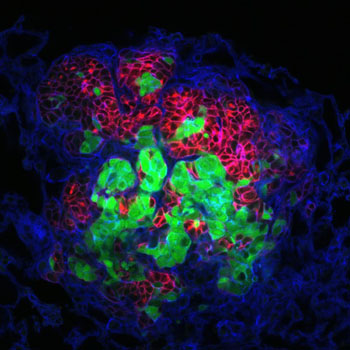Polyclonal Breast Cancer Metastases Are Generated by Clusters of Migrating Cells
By LabMedica International staff writers
Posted on 14 Feb 2016
A recent study confirmed that, contrary to conventional wisdom, cancer metastasis usually depends on the release of clusters of cells rather than single cells from the primary tumor.Posted on 14 Feb 2016
Conventional models of cancer progression propose that single cells leave the primary tumor, enter the circulation, and seed metastases based on the clonal type of that cell. However, metastases can contain multiple clones, raising the question of how polyclonal metastases are formed.

Image: A metastasis now growing in lung tissue (blue) that originated from at least two cells (red and green) from a multicolored tumor in the mammary gland of a mouse (Photo courtesy of Breanna Moore, Cheung laboratory, Fred Hutchinson Cancer Research Center).
To answer this question investigators at Johns Hopkins University (Baltimore, MD, USA) used multicolor lineage tracing to follow red or green tagged cells as they escaped from a primary tumor (in culture or in a mouse model) to form daughter tumors.
They reported in the February 1, 2016, online edition of the journal Proceedings of the National Academy of Sciences of the United States of America (PNAS) that polyclonal seeding by cell clusters was the most frequent mechanism in a common mouse model of breast cancer, accounting for more than 90% of metastases. They directly observed multicolored tumor cell clusters across major stages of metastasis, including collective invasion, local dissemination, intravascular emboli, circulating tumor cell clusters, and micrometastases.
Experimentally aggregating tumor cells into clusters induced a greater than 15-fold increase in colony formation in three-dimensional in vitro gel culture and a greater than 100-fold increase in metastasis formation in a mouse model.
The investigators found that the most invasive clones frequently expressed the epithelial cytoskeletal protein, keratin 14 (K14), which regulated cell-cell adhesion, cell-matrix adhesion, and immune evasion. When K14 expression was blocked, there was a dramatic reduction in formation of distant metastases combined with disrupted expression of multiple metastasis effectors.
“We found that cancer cells do two things to increase their chances of forming a new metastasis,” said senior author Dr. Andrew Ewald, associate professor of cell biology at Johns Hopkins University. “They turn on a molecular program that helps them travel through a diverse set of environments within the body, and they travel in groups.”
“Because most chemotherapeutic drugs target proliferating cells, metastasizing cells would not be killed by them, leaving patients vulnerable to new tumors,” said Dr. Ewald. “Our discoveries add to knowledge that could help overcome that vulnerability. We found that the activity of dozens of genes differs between proliferating and metastasizing cells. Since many of those genes encode cell surface proteins, we hope these findings might eventually be used to develop new drugs that target metastasizing cells.”
Related Links:
Johns Hopkins University










 (3) (1).png)



